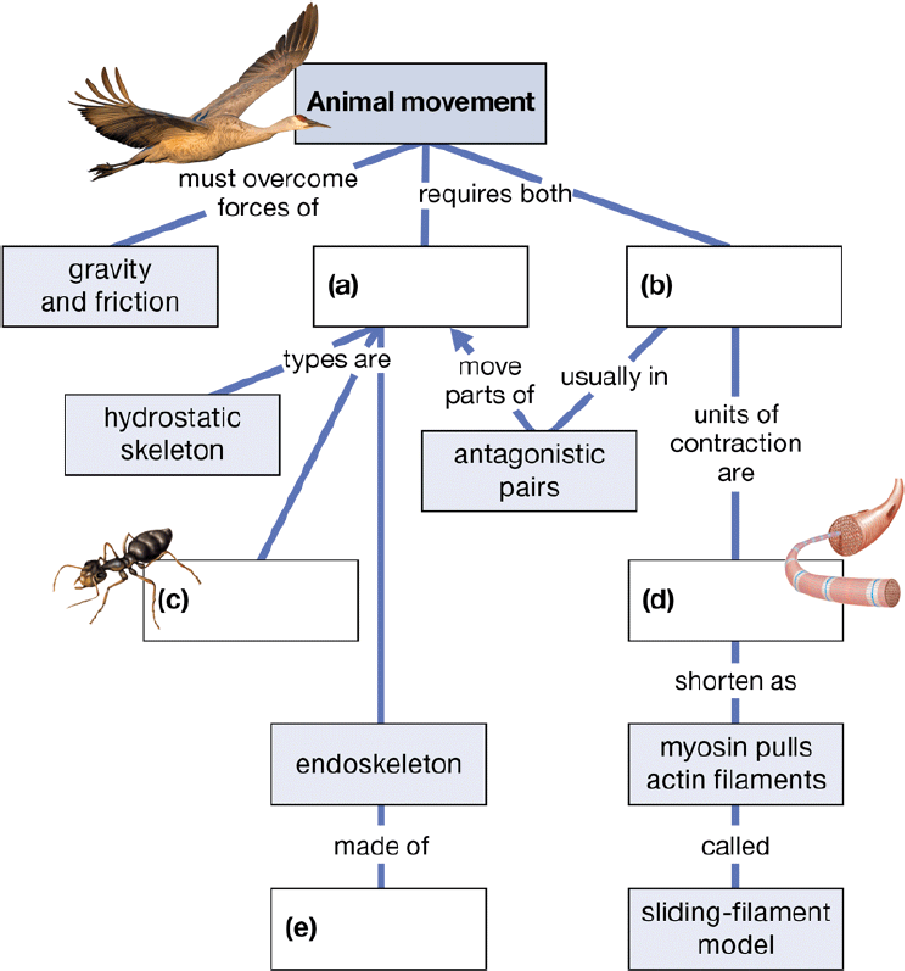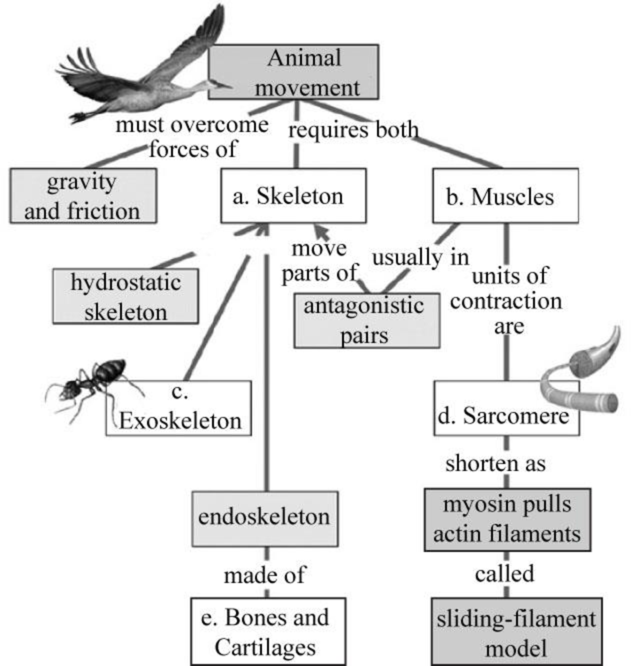
Concept explainers
Complete this concept map on animal movement.

To complete: The given map showing the animal movement.
Introduction:
Movement is a distinguishing characteristic of animals. Even animals that are attached to a substrate move their body parts. All types of animal movement have underlying similarities. At the cellular level, every form of movement involves protein strands moving against one another, an energy-consuming process.
Explanation of Solution
Pictorial representation:
Fig. 1 shows the completed map of the animal movement.

Fig. 1: Completed map of the animal movement
(a)
Correct answer: Skeleton.
Movement in animals requires both the skeleton as well as the muscle. There are many types of skeletons present among the various organisms, which include the endoskeleton, exoskeleton, and hydrostatic skeleton. Each skeleton is associated with different types of movement, such as, flying, walking, running, crawling, and others. Hence, the correct answer is skeleton.
(b)
Correct answer: Muscles.
In every organism, muscles are required to generate a required amount of energy, whether walking, running, swimming, or flying. Hence, the correct answer is muscles.
(c)
Correct answer: Exoskeleton.
The skeletons found among the diverse group of organisms are categorized into three types, which include the endoskeleton, hydrostatic skeleton, and exoskeleton. The exoskeleton is primarily found in the insects. Hence, the correct answer is exoskeleton.
(d)
Correct answer: Sarcomere.
Sarcomeres are the units of muscle contraction; they are found in the striated muscles and are present between 2-Z lines as a repeating unit. Hence, the correct answer is sarcomere.
(e)
Correct answer: Bones and Cartilages.
Endoskeletons are present inside the body and made up of bones and cartilages. Usually, all the vertebrates have a skeleton type as an endoskeleton. Hence, the correct answer is bones and cartilages.
Want to see more full solutions like this?
Chapter 30 Solutions
Campbell Biology: Concepts and Connections (Custom Package)
- create a brief guide to the structure and function of vertebrate muscle. Points that you need to consider include cell shape; cell size; number of nuclei per cell; position of the nuclei; presence or absence of striations; presence or absence of branching; and presence or absence of intercalated discs.arrow_forwardDescribe how a snake moves by lateral undulation. Why might this form of locomotion be inefficient on an unstable surface (such as sand) or a surface lacking irregularities? What forms of locomotion would work for a snake under these conditions?arrow_forwardWorms use a hydrostatic skeleton to generate movement. How do they do this? a. Their bones are filled with water, which provides the weight of the skeleton. b. The change in body structure is caused by contraction of muscles compressing the watery body fluid. c. The muscles contain water vacuoles, which, when filled, provide a rigid internal structure. d. The term hydrostatic simply refers to moist environment. They generate movement just as arthropods do.arrow_forward
- In which of the following taxa would you find an iris sphincter muscle used for accommodation? Question 10 options: A) Amphibians B) Snakes C) Lampreys D) Mammals E) Birds F) Bony fisharrow_forward2) Enumerate some examples of muscles in frogs that can be characterized by their specific action. Write all answers in Table 7.6 below. Table 7.6. Examples of muscles with different action Muscle Action Example of Muscle Location of Muscle Agonist Antagonist Synergistarrow_forwardGive other examples and uses of animal movementsarrow_forward
- explain why a person bringing 50 kg sack of rice will not move in the same speed and duration as one running in a marathon based on the concept of skeletal muscle contractionarrow_forwardDuring a chimpanzee's bipedal locomotion, what does the upper body naturally do? During a human's bipedal locomotion, what does the upper body naturally do?arrow_forwardWhat aspect of creatine phosphate allows it to supply energy to muscles? ATPase activity phosphate bonds carbon bonds hydrogen bondsarrow_forward
- Relate the structure of insect flight muscles to their function.arrow_forwardmuscle spidnles are _____ receptors and provide ____ information, whereas golgi tendon organs respond primarily to ___ and cause a ____ reaction 1. Tension 2. Sensory 3. relaxation 4. stretcharrow_forwardGather information on the structure and function of skeletal, cardiac and smooth muscle. Combine all this information to create a brief guide to the structure and function of vertebrate muscle. Points that you need to consider include cell shape; cell size; number of nuclei per cell; position of the nuclei; presence or absence of striations; presence or absence of branching; and presence or absence of intercalated discs.b) Follow the table with a one-sentence explanation of what an intercalateddisc is. c) Briefly explain what happens to actin and myosin in muscle during rigor mortis.arrow_forward

 Anatomy & PhysiologyBiologyISBN:9781938168130Author:Kelly A. Young, James A. Wise, Peter DeSaix, Dean H. Kruse, Brandon Poe, Eddie Johnson, Jody E. Johnson, Oksana Korol, J. Gordon Betts, Mark WomblePublisher:OpenStax College
Anatomy & PhysiologyBiologyISBN:9781938168130Author:Kelly A. Young, James A. Wise, Peter DeSaix, Dean H. Kruse, Brandon Poe, Eddie Johnson, Jody E. Johnson, Oksana Korol, J. Gordon Betts, Mark WomblePublisher:OpenStax College Biology (MindTap Course List)BiologyISBN:9781337392938Author:Eldra Solomon, Charles Martin, Diana W. Martin, Linda R. BergPublisher:Cengage Learning
Biology (MindTap Course List)BiologyISBN:9781337392938Author:Eldra Solomon, Charles Martin, Diana W. Martin, Linda R. BergPublisher:Cengage Learning Human Physiology: From Cells to Systems (MindTap ...BiologyISBN:9781285866932Author:Lauralee SherwoodPublisher:Cengage Learning
Human Physiology: From Cells to Systems (MindTap ...BiologyISBN:9781285866932Author:Lauralee SherwoodPublisher:Cengage Learning Biology: The Dynamic Science (MindTap Course List)BiologyISBN:9781305389892Author:Peter J. Russell, Paul E. Hertz, Beverly McMillanPublisher:Cengage Learning
Biology: The Dynamic Science (MindTap Course List)BiologyISBN:9781305389892Author:Peter J. Russell, Paul E. Hertz, Beverly McMillanPublisher:Cengage Learning





